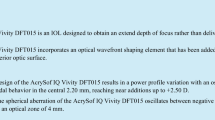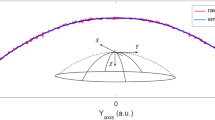Abstract
Purpose
A new class of enhanced range of vision intraocular lenses (IOLs) has been introduced recently to cope with compromises of diffractive optics in patients aiming for spectacle independence. Few information is available about their optical function. We aimed to analyze higher order aberrations of four of these new wavefront-shaped IOLs under standardized conditions.
Methods
Two recently developed enhanced monofocal and two recently developed enhanced depth of focus IOLs (power 22 D) were analyzed by a Shack–Hartmann sensor in an in-situ model eye according to ISO 11,979 in NaCl with 546 nm. We determined the Zernike polynomials up to the 10th order.
Results
Only spherical aberration (SA) of different orders was considerably modified. Whereas RaySof EMV showed a moderate increase in Z 4–0, Eyhance and Vivity produced a considerable increase of negative Z 4–0. A combination of Z 4–0 and Z 6–0 with an opposite sign was found in LuxSmart.
Conclusion
SAs of different orders are the only relevant Zernike polynomials in this new class of wavefront-shaped IOLs. RaySof EMV proved to be a monofocal IOL with increased positive SA. The central change in radial power and the resulting increase in negative SA in Eyhance IOL might produce some depth of field. The magnitude of SA modification of Vivity and LuxSmart is expected to extend the depth of focus considerably. Surgeons can select among these novel IOLs depending on corneal asphericity and the patient’s wish for spectacle independence.











Similar content being viewed by others
Availability of data and materials
(Data transparency) yes, from the author upon request.
Code availability
Not applicable.
References
Kamiya K, Hayashi K, Shimizu K, et al (2014) Survey Working Group of the Japanese Society of Cataract and Refractive Surgery. Multifocal intraocular lens explantation: a case series of 50 eyes. Am J Ophthalmol 158(2):215–220.e1. https://doi.org/10.1016/j.ajo.2014.04.010
De Silva SR, Evans JR, Kirthi V et al (2016) Multifocal versus monofocal intraocular lenses after cataract extraction. Cochrane Database Syst Rev 12(12):CD003169. https://doi.org/10.1002/14651858.CD003169.pub4
Auffarth GU, Gerl M, Tsai L, et al (2021) Quantum Study Group. Clinical evaluation of a new monofocal IOL with enhanced intermediate function in patients with cataract. J Cataract Refract Surg 47(2):184–191. https://doi.org/10.1097/j.jcrs.0000000000000399
Holladay JT, Piers PA, Koranyi G et al (2002) A new intraocular lens design to reduce spherical aberration of pseudophakic eyes. J Refract Surg 18(6):683–691
Rocha KM, Vabre L, Chateau N et al (2009) Expanding depth of focus by modifying higher-order aberrations induced by an adaptive optics visual simulator. J Cataract Refract Surg 35:1885–1892. https://doi.org/10.1016/j.jcrs.2009.05.059
Rocha KM (2017) Extended depth of focus IOLs: the next chapter in refractive technology? Editorial. J Cataract Refract Surg 33:146–149. https://doi.org/10.3928/1081597X-20170217-01
Schuster AK, Tesarz J, Vossmerbaeumer U (2015) Ocular wavefront analysis of aspheric compared with spherical monofocal intraocular lenses in cataract surgery: systematic review with metaanalysis. J Cataract Refract Surg 41(5):1088–1097. https://doi.org/10.1016/j.jcrs.2015.04.005
Rayner (2020) RayOne EMV: first clinical results. https://rayner.com/wp-content/uploads/2020/10/RayOne-EMV-First-Clinical-Results-1.pdf. Accessed 24 Jan 2021
Alarcon A, Cánovas C, Koopman B et al (2020) Enhancing the intermediate vision of monofocal intraocular lenses using a higher order aspheric optic. J Refract Surg 36(8):520–527. https://doi.org/10.3928/1081597X-20200612-01
Schallhorn JM (2021) Multifocal and extended depth of focus intraocular lenses: a comparison of data from the United States Food and Drug Administration premarket approval trials. J Refract Surg 37(2):98–104. https://doi.org/10.3928/1081597X-20201111-02
Food and Drug Administration (2020) Summary of safety and effectiveness data. AcrySofTM IQ VivityTM Extended Vision Intraocular Lens. https://www.accessdata.fda.gov/cdrh_docs/pdf/P930014S126B.pdf. Accessed 24 Jan 2021
Yi F, Iskander DR, Collins M (2011) Depth of focus and visual acuity with primary and secondary spherical aberration. Vision Res 51(14):1648–1658. https://doi.org/10.1016/j.visres.2011.05.006
Benard Y, Lopez-Gil N, Legras R (2011) Optimizing the subjective depth-of-focus with combinations of fourth- and sixth-order spherical aberration. Vision Res 51(23–24):2471–2477. https://doi.org/10.1016/j.visres.2011.10.003
MacRae S, Holladay JT, Glasser A et al (2017) Special report: American Academy of Ophthalmology Task Force consensus statement for extended depth of focus intraocular lenses. Ophthalmology 124:139–141. https://doi.org/10.1016/j.ophtha.2016.09.034
TRIOPTICS GmbH (2021) OptiSpheric. https://trioptics.com/products/optispheric-focal-length-and-radius-measurement/. Accessed 02 May 2021
Mencucci R, Cennamo M, Venturi D et al (2020) Visual outcome, optical quality, and patient satisfaction with a new monofocal IOL, enhanced for intermediate vision: preliminary results. J Cataract Refract Surg 46(3):378–387. https://doi.org/10.1097/j.jcrs.0000000000000061
Unsal U, Sabur H (2021) Comparison of new monofocal innovative and standard monofocal intraocular lens after phacoemulsification. Int Ophthalmol 41(1):273–282. https://doi.org/10.1007/s10792-020-01579-y
Del Águila-Carrasco AJ, Read SA, Montés-Micó R et al (2017) The effect of aberrations on objectively assessed image quality and depth of focus. J Vis 17(2):2. https://doi.org/10.1167/17.2.2
Piers PA, Manzanera S, Prieto PM et al (2007) Use of adaptive optics to determine the optimal ocular spherical aberration. J Cataract Refract Surg 33(10):1721–1726. https://doi.org/10.1016/j.jcrs.2007.08.001
Wang L, Koch DD (2020) Intraocular lens power calculations in eyes with previous corneal refractive surgery: review and expert opinion. Ophthalmology S0161–6420(20)30625–4. https://doi.org/10.1016/j.ophtha.2020.06.054
Coassin M, Di Zazzo A, Antonini M et al (2020) Extended depth-of-focus intraocular lenses: power calculation and outcomes. J Cataract Refract Surg 46(11):1554–1560. https://doi.org/10.1097/j.jcrs.0000000000000293
Eppig T, Rawer A, Hoffmann P et al (2020) On the chromatic dispersion of hydrophobic and hydrophilic intraocular lenses. Optom Vis Sci 97(4):305–313. https://doi.org/10.1097/OPX.0000000000001495
Radmall BR et al (2015) Refractive index and its impact on pseudophakic dysphotopsia. Clin Ophthalmol 9:1353–1358. https://doi.org/10.2147/OPTH.S86980.eCollection2015
Nakajima M, Hiraoka T, Yamamoto T, et al (2016) Differences of longitudinal chromatic aberration (LCA) between eyes with intraocular lenses from different manufacturers. PLoS ONE 11(6):e0156227. https://doi.org/10.1371/journal.pone.0156227. eCollection 2016
Author information
Authors and Affiliations
Contributions
Schmid and Borkenstein: concept, evaluation, and writing. Luedtke: data analysis.
Corresponding author
Ethics declarations
Ethics approval
This article does not contain any studies with human participants performed by any of the authors.
Not applicable.
Conflict of interest
The authors declare no competing interests.
Additional information
Publisher's note
Springer Nature remains neutral with regard to jurisdictional claims in published maps and institutional affiliations.
Rights and permissions
About this article
Cite this article
Schmid, R., Borkenstein, A.F. Analysis of higher order aberrations in recently developed wavefront-shaped IOLs. Graefes Arch Clin Exp Ophthalmol 260, 609–620 (2022). https://doi.org/10.1007/s00417-021-05362-2
Received:
Revised:
Accepted:
Published:
Issue Date:
DOI: https://doi.org/10.1007/s00417-021-05362-2




